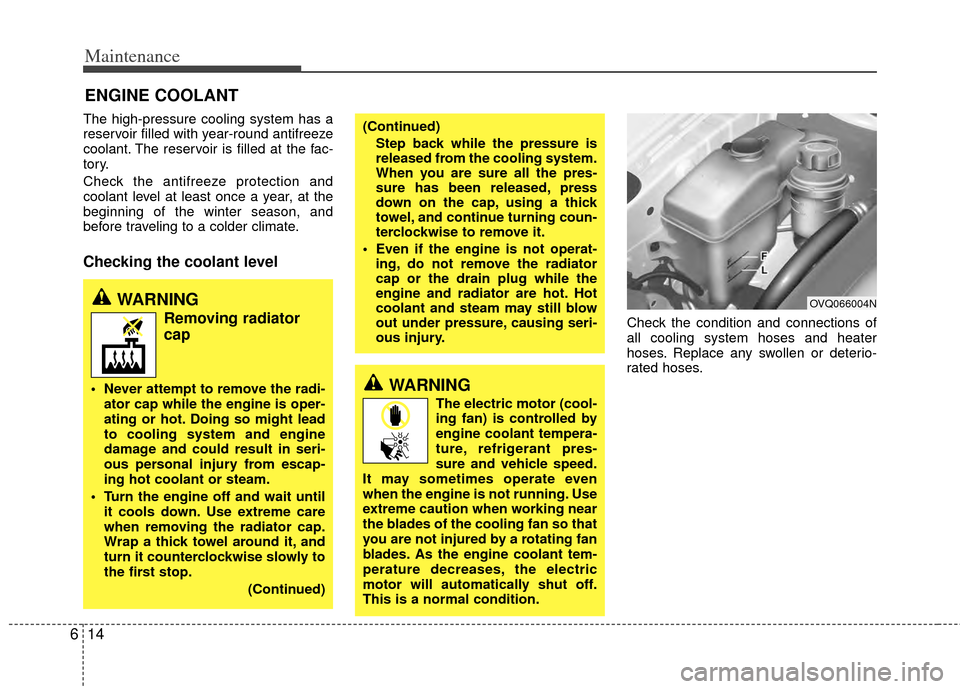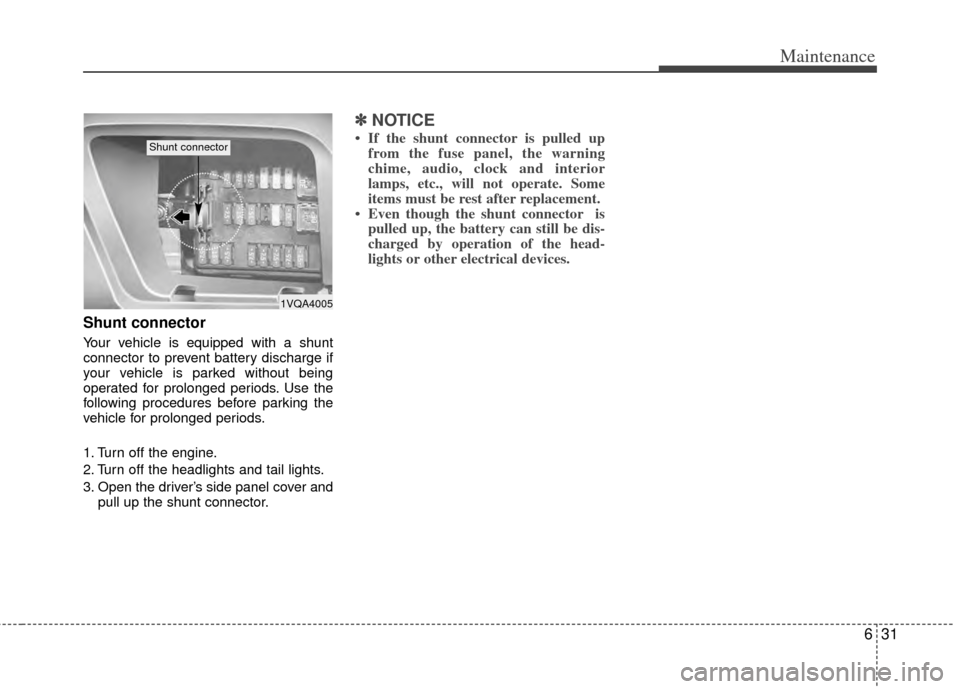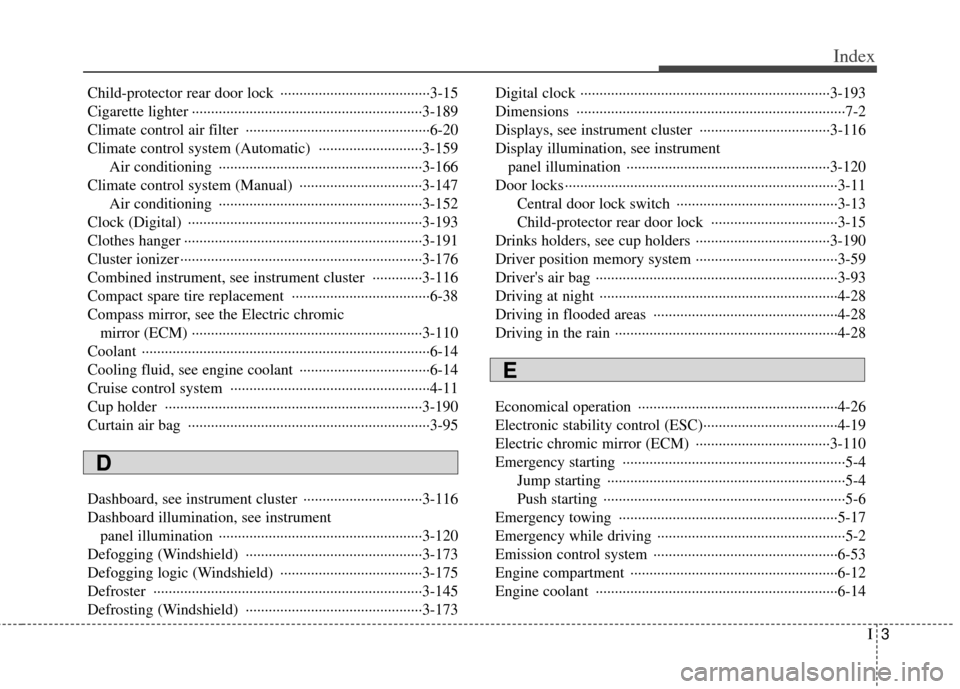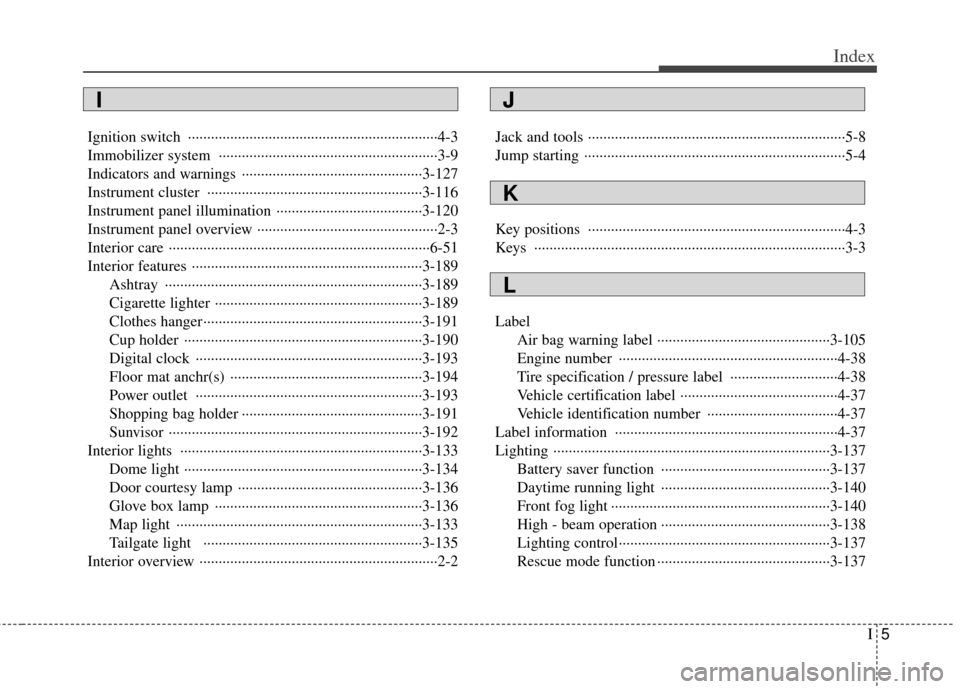2014 KIA Sedona clock
[x] Cancel search: clockPage 330 of 382

Maintenance
14
6
ENGINE COOLANT
The high-pressure cooling system has a
reservoir filled with year-round antifreeze
coolant. The reservoir is filled at the fac-
tory.
Check the antifreeze protection and
coolant level at least once a year, at the
beginning of the winter season, and
before traveling to a colder climate.
Checking the coolant level
Check the condition and connections of
all cooling system hoses and heater
hoses. Replace any swollen or deterio-
rated hoses.
WARNING
Removing radiator
cap
Never attempt to remove the radi-
ator cap while the engine is oper-
ating or hot. Doing so might lead
to cooling system and engine
damage and could result in seri-
ous personal injury from escap-
ing hot coolant or steam.
Turn the engine off and wait until it cools down. Use extreme care
when removing the radiator cap.
Wrap a thick towel around it, and
turn it counterclockwise slowly to
the first stop.
(Continued)
(Continued)Step back while the pressure is
released from the cooling system.
When you are sure all the pres-
sure has been released, press
down on the cap, using a thick
towel, and continue turning coun-
terclockwise to remove it.
Even if the engine is not operat- ing, do not remove the radiator
cap or the drain plug while the
engine and radiator are hot. Hot
coolant and steam may still blow
out under pressure, causing seri-
ous injury.
OVQ066004N
WARNING
The electric motor (cool-
ing fan) is controlled by
engine coolant tempera-
ture, refrigerant pres-
sure and vehicle speed.
It may sometimes operate even
when the engine is not running. Use
extreme caution when working near
the blades of the cooling fan so that
you are not injured by a rotating fan
blades. As the engine coolant tem-
perature decreases, the electric
motor will automatically shut off.
This is a normal condition.
Page 343 of 382

627
Maintenance
Driver's side fuse panel
Description Fuse ratingProtected component
AUDIO15A Audio, Step lamp
MEMORY 7.5A Climate control module, Clock, Cluster, Trip computer, Front area module, Power sliding door module, Power
tailgate module, Driver's door module, Front passenger door module, Driver's power seat module,
Driver position memory system unit
VRS 10A Variable rack stroke system module, Variable rack stroke system control button
IG2-1 7.5A Air conditioner control module, Multi function switch, Inside relay box, ECM mirror, Rain sensor, Seat Warmer
IG2-2 7.5A Rear climate control button, Front area module, Power sliding door module, Power tailgate module, Driver's door
module, Front passenger door module, Driver's power seat module, Driver position memory system unit
OBD-II 7.5A OBD-II, Diagonosis connector
ROOM 7.5A Vanity mirror, Map lamp, Overhead console, Room lamp switch, Climate control module, Homelink
K/LOCK 7.5A Key interlock solenoid
ILLUMI 7.5A Instrument panel illumination
AMP 25A Amplifier
SEAT WARMER 20A Inside relay box(Seat warmer)
SUNROOF 25A Sunroof module
DDM 30A Driver's door module
TPMS 7.5A Tire pressure monitoring system
PEDAL 15A Power adjustable pedal relay(None-driver position memory system only)
P/OUTLET 1 15A Power outlet(Front)
ASS P/SEAT 20A Front passenger's power seat module
DRV P/SEAT 30A Driver's power seat module
ADM 30A Front passenger door module
ACC 7.5A Audio, Clock, Outside rearview mirror control and folding switch
P/OUTLET 2 15A Cigar lighter, Power outlet
START 7.5A Start relay
AIRBAG IND 7.5A Cluster
Page 347 of 382

631
Maintenance
Shunt connector
Your vehicle is equipped with a shunt
connector to prevent battery discharge if
your vehicle is parked without being
operated for prolonged periods. Use the
following procedures before parking the
vehicle for prolonged periods.
1. Turn off the engine.
2. Turn off the headlights and tail lights.
3. Open the driver’s side panel cover andpull up the shunt connector.
✽ ✽NOTICE
• If the shunt connector is pulled up
from the fuse panel, the warning
chime, audio, clock and interior
lamps, etc., will not operate. Some
items must be rest after replacement.
• Even though the shunt connector is pulled up, the battery can still be dis-
charged by operation of the head-
lights or other electrical devices.
1VQA4005
Shunt connector
Page 349 of 382

633
Maintenance
For best battery service:
Keep the battery securely mounted.
Keep the battery top clean and dry.
Keep the terminals and connectionsclean, tight, and coated with petroleum
jelly or terminal grease.
Rinse any spilled electrolyte from the battery immediately with a solution of
water and baking soda.
If the vehicle is not going to be used for an extended time, disconnect the bat-
tery cables.
Battery recharging
Your vehicle has a maintenance-free,
calcium-based battery.
If the battery becomes discharged in ashort time (because, for example, the
headlights or interior lights were left on
while the vehicle was not in use),
recharge it by slow charging (trickle)
for 10 hours. If the battery gradually discharges
because of high electric load while the
vehicle is being used, recharge it at 20-
30A for two hours.
Items to be reset after the battery
has been discharged or the bat-
tery has been disconnected.
Clock (See Chapter 3)
Sunroof (See Chapter 3)
Trip computer (See Chapter 3)
Climate control system (See Chapter3)
Audio (See Chapter 3)
Power sliding door and power tailgate (See Chapter 3)
CAUTION
If you connect unauthorized elec-tronic devices to the battery, thebattery may be discharged. Neveruse unauthorized devices.
CAUTION
Before performing maintenance or recharging the battery, turn offall accessories and stop theengine.
The negative battery cable must be removed first and installed lastwhen the battery is disconnected.
WARNING- Recharging battery
When recharging the battery,
observe the following precautions:
The battery must be removed
from the vehicle and placed in an
area with good ventilation.
Do not allow cigarettes, sparks, or flame near the battery.
(Continued)
(Continued)
Watch the battery during charg-ing, and stop or reduce the charg-
ing rate if the battery cells begin
gassing (boiling) violently or if
the temperature of the electrolyte
of any cell exceeds 49°C (120°F).
Wear eye protection when check- ing the battery during charging.
Disconnect the battery charger in the following order.
1. Turn off the battery charger main switch.
2. Unhook the negative clamp from the negative battery terminal.
3. Unhook the positive clamp from the positive battery terminal.
Page 377 of 382

I3
Index
Child-protector rear door lock ··················\
··················\
···3-15
Cigarette lighter ··················\
··················\
··················\
······3-189
Climate control air filter ··················\
··················\
············6-20
Climate control system (Automatic) ··················\
·········3-159Air conditioning ··················\
··················\
·················3-16\
6
Climate control system (Manual) ··················\
··············3-147 Air conditioning ··················\
··················\
·················3-15\
2
Clock (Digital) ··················\
··················\
··················\
·······3-193
Clothes hanger ··················\
··················\
··················\
········3-191
Cluster ionizer ··················\
··················\
··················\
·········3-176
Combined instrument, see instrument cluster ·············3-116
Compact spare tire replacement ··················\
··················\
6-38
Compass mirror, see the Electric chromic mirror (ECM) ···············\
··················\
··················\
·········3-110
Coolant ················\
··················\
··················\
··················\
·····6-14
Cooling fluid, see engine coolant ··················\
················6-14
Cruise control system ··················\
··················\
················4-11
Cup holder ··················\
··················\
··················\
·············3-190
Curtain air bag ··················\
··················\
··················\
·········3-95
Dashboard, see instrument cluster ··················\
·············3-116
Dashboard illumination, see instrument panel illumination ··················\
··················\
·················3-12\
0
Defogging (Windshield) ··················\
··················\
··········3-173
Defogging logic (Windshield) ··················\
··················\
·3-175
Defroster ················\
··················\
··················\
··················\
3-145
Defrosting (Windshield) ··················\
··················\
··········3-173 Digital clock ··················\
··················\
··················\
···········3-193
Dimensions ················\
··················\
··················\
··················\
7-2
Displays, see instrument cluster ··················\
················3-116
Display illumination, see instrument
panel illumination ··················\
··················\
·················3-12\
0
Door locks ··················\
··················\
··················\
·················3-11\
Central door lock switch ··················\
··················\
······3-13
Child-protector rear door lock ··················\
···············3-15
Drinks holders, see cup holders ··················\
·················3-19\
0
Driver position memory system ··················\
··················\
·3-59
Driver's air bag ··················\
··················\
··················\
·········3-93
Driving at night ··················\
··················\
··················\
········4-28
Driving in flooded areas ··················\
··················\
············4-28
Driving in the rain ··················\
··················\
··················\
····4-28
Economical operation ··················\
··················\
················4-26
Electronic stability control (ESC)··················\
·················4-19\
Electric chromic mirror (ECM) ··················\
·················3-11\
0
Emergency starting ··················\
··················\
··················\
····5-4 Jump starting ··················\
··················\
··················\
········5-4
Push starting ··················\
··················\
··················\
·········5-6
Emergency towing ··················\
··················\
··················\
···5-17
Emergency while driving ··················\
··················\
·············5-2
Emission control system ··················\
··················\
············6-53
Engine compartment ··················\
··················\
··················\
6-12
Engine coolant ··················\
··················\
··················\
·········6-14
D
E
Page 379 of 382

I5
Index
Ignition switch ··················\
··················\
··················\
···········4-3
Immobilizer system ··················\
··················\
··················\
···3-9
Indicators and warnings ··················\
··················\
···········3-127
Instrument cluster ··················\
··················\
··················\
··3-116
Instrument panel illumination ··················\
··················\
··3-120
Instrument panel overview ··················\
··················\
···········2-3
Interior care ··················\
··················\
··················\
··············6-51
Interior features ··················\
··················\
··················\
······3-189Ashtray ················\
··················\
··················\
···············3-189
Cigarette lighter ··················\
··················\
··················\
3-189
Clothes hanger··················\
··················\
··················\
···3-191
Cup holder ··················\
··················\
··················\
········3-190
Digital clock ··················\
··················\
··················\
·····3-193
Floor mat anchr(s) ··················\
··················\
··············3-194
Power outlet ··················\
··················\
··················\
·····3-193
Shopping bag holder ··················\
··················\
···········3-191
Sunvisor ·················\
··················\
··················\
·············3-192
Interior lights ··················\
··················\
··················\
·········3-133 Dome light ··················\
··················\
··················\
········3-134
Door courtesy lamp ··················\
··················\
············3-136
Glove box lamp ··················\
··················\
··················\
3-136
Map light ··················\
··················\
··················\
··········3-133
Tailgate light ··················\
··················\
··················\
···3-135
Interior overview ··················\
··················\
··················\
········2-2 Jack and tools ··················\
··················\
··················\
·············5-8
Jump starting ··················\
··················\
··················\
··············5-4
Key positions ··················\
··················\
··················\
·············4-3
Keys ··················\
··················\
··················\
··················\
·········3-3
Label
Air bag warning label ··················\
··················\
·········3-105
Engine number ··················\
··················\
··················\
···4-38
Tire specification / pressure label ··················\
··········4-38
Vehicle certification label ··················\
··················\
·····4-37
Vehicle identification number ··················\
················4-37
Label information ··················\
··················\
··················\
····4-37
Lighting ················\
··················\
··················\
··················\
··3-137 Battery saver function ··················\
··················\
········3-137
Daytime running light ··················\
··················\
········3-140
Front fog light ··················\
··················\
··················\
···3-140
High - beam operation ··················\
··················\
········3-138
Lighting control··················\
··················\
··················\
·3-137
Rescue mode function ··················\
··················\
·········3-137
K
J
L
I